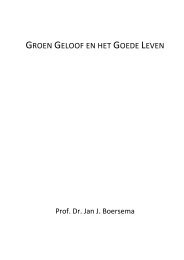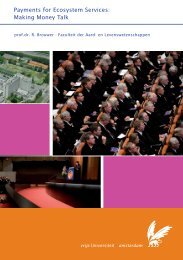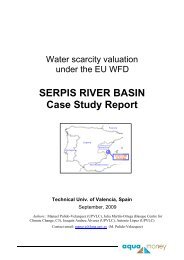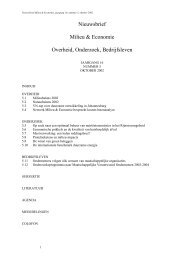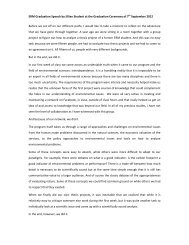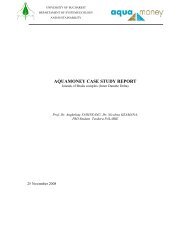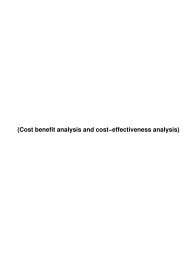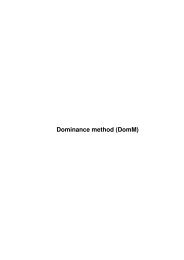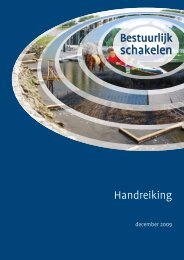Case study report Po Italy - VU University, Institute for Environmental ...
Case study report Po Italy - VU University, Institute for Environmental ...
Case study report Po Italy - VU University, Institute for Environmental ...
You also want an ePaper? Increase the reach of your titles
YUMPU automatically turns print PDFs into web optimized ePapers that Google loves.
AquaMoney<br />
Table 49: Model fitting<br />
Model fitting criteria<br />
Likelihood Ratio Tests<br />
Model - 2Log Likelihood Chi-Square df Sig.<br />
Intercept only 670.581<br />
Final 2152.808 318.77 5 0<br />
In the questionnaire we also used the CVM method to ask directly the maximum wtp <strong>for</strong> the economic sectors and<br />
environment. In this case the highest WTP obtained by the environment. Among sectors, the ones with the highest WTP<br />
are confirmed to be agriculture and energy production.<br />
Table 50: Willingness to pay derived from CVM<br />
Mean (€/famiglia) Median (€/famiglia) Sd Frequency wtp =0<br />
Environment 42.96 30 63.03 23.70%<br />
Agriculture 29.95 10 43.12 34.90%<br />
Energy 23.38 10 42.63 44.80%<br />
Industry 13.87 0 25.74 55.80%<br />
7.3 Comparison between sub-basins<br />
This section is devoted to the comparison between the two sub-samples belonging to the two main basins considered. In<br />
particular, we compare the characteristics and the results of CVM <strong>for</strong> the data coming out of the IT2 sample. We split<br />
the data in two parts related two different basins. The first sub-sample is located in the Reno-Romagna basin with a size<br />
of 159 people and the second sample in the <strong>Po</strong> basin with a size of 191 people.<br />
In the following a description of the main sample characteristics is <strong>report</strong>ed. The aim of the description is to know how<br />
the samples differ.<br />
In both samples the sex distribution shows a larger presence of male respect to the <strong>Italy</strong> sex distribution (see Table 51).<br />
Table 51: Sex distribution in the two samples<br />
Sex Reno <strong>Po</strong><br />
Male 54.97% 52.83%<br />
Female 45.03% 45.28%<br />
- 0.00% 1.89%<br />
Tot 100.00% 100.00%<br />
The average age is 47 in the Reno sample and 43 in the <strong>Po</strong> sample. In particular in the <strong>Po</strong> basin the presence of people<br />
over 65 years old is less than in Reno and the interval class with the highest frequency is 35-45 years old (see Table 52).<br />
Table 52: Age distribution in the two samples<br />
Age Reno <strong>Po</strong> Age Reno <strong>Po</strong><br />
65 19.37% 6.29%<br />
35-45 20.94% 37.74% - 0.00% 1.26%<br />
45-55 20.42% 20.13% Tot 100.00% 100.00%<br />
Differences between samples can be understand analysing the job distribution (Table 53). In fact, in the Reno basin the<br />
presence of retired is larger than in the <strong>Po</strong> (21% vs. 8%) and the farmers presence is larger in the <strong>Po</strong> basin than in the<br />
Reno (13% vs. 5%). In the <strong>Po</strong> basin the presence of fisherman depends on the possibility to make the activity as a job.<br />
26





